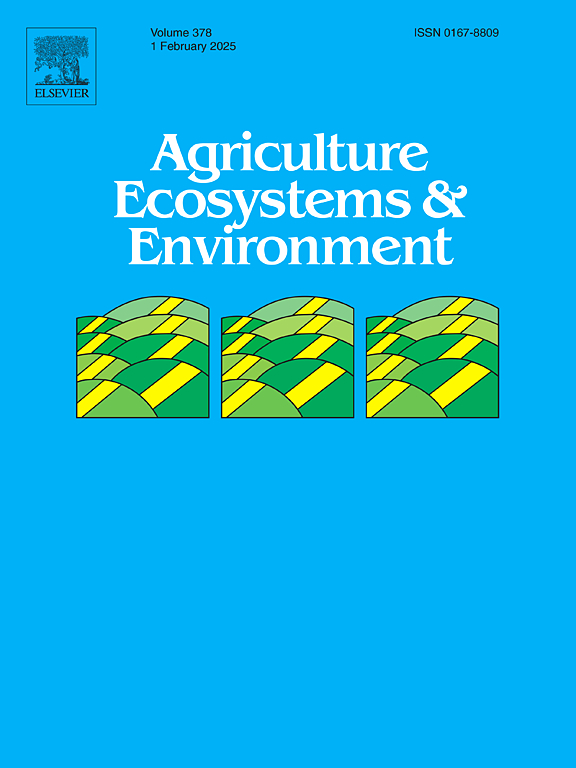Floral strips adjacent to rotationally managed crop fields significantly increase nesting density and support pollen foraging of leafcutter bees
IF 6
1区 农林科学
Q1 AGRICULTURE, MULTIDISCIPLINARY
引用次数: 0
Abstract
- 1.Bees in many regions of the world are in decline with strong evidence that agricultural practices are to blame. Although wildflower enhancements adjacent to croplands have proven effective at increasing wild bee abundance and diversity, how these enhancements can improve the diet and nesting density of bees remains poorly known.
- 2.We placed hollow reeds next to floral strips, control fields, and semi-natural areas in Manitoba from 2019–2021 to determine how pollen utilization and provisioning density of stem-nesting leafcutter bees (Megachile) differed between treatments.
- 3.We found that strip sites significantly increased nesting density of Megachile when compared to the other treatments. Strip sites contained the most pollen species, including 30 % of species sown into the floral strip itself, suggesting that Megachile use the strip for pollen provisioning.
- 4.At the landscape scale, nesting density of Megachile responded positively to the amount of rewarding agriculture (crops frequently visited by insects for floral rewards). However, the number of offspring per nest responded negatively to rewarding agriculture and local Shannon vegetation diversity, indicating that Megachile create more nests with fewer offspring in areas of large-scale flowering crops or higher vegetation diversity. Possible reasons for this are discussed.
- 5.Our research supports the idea that floral strips increase beneficial insect abundance and that floral strips supplement pollen foraging of bees.
靠近轮作农田的花带显著增加了切叶蜂的筑巢密度和花粉觅食
1.世界上许多地区的蜜蜂数量正在下降,有强有力的证据表明,农业实践是罪魁祸首。虽然在农田附近种植野花已被证明对增加野生蜜蜂的数量和多样性是有效的,但这些增强措施如何改善蜜蜂的饮食和筑巢密度仍然知之甚少。从2019年到2021年,我们在曼尼托巴省的花带、对照田和半自然区域旁边放置空心芦苇,以确定茎巢切叶蜂(Megachile)的花粉利用和供应密度在不同处理之间的差异。我们发现,与其他处理相比,带状场地显著增加了巨蝉的筑巢密度。带状地点含有最多的花粉种类,其中30% %的花粉种被播种到花条上,这表明Megachile利用花条提供花粉。在景观尺度上,Megachile的筑巢密度与奖励农业(昆虫经常访问的作物以获得花卉奖励)的数量呈正相关。然而,每个巢的后代数量对农业奖励和当地香农植被多样性负相关,这表明在大规模开花作物或植被多样性较高的地区,Megachile建造的巢更多,后代更少。讨论了可能的原因。我们的研究支持了花条增加有益昆虫数量和补充蜜蜂花粉觅食的观点。
本文章由计算机程序翻译,如有差异,请以英文原文为准。
求助全文
约1分钟内获得全文
求助全文
来源期刊

Agriculture, Ecosystems & Environment
环境科学-环境科学
CiteScore
11.70
自引率
9.10%
发文量
392
审稿时长
26 days
期刊介绍:
Agriculture, Ecosystems and Environment publishes scientific articles dealing with the interface between agroecosystems and the natural environment, specifically how agriculture influences the environment and how changes in that environment impact agroecosystems. Preference is given to papers from experimental and observational research at the field, system or landscape level, from studies that enhance our understanding of processes using data-based biophysical modelling, and papers that bridge scientific disciplines and integrate knowledge. All papers should be placed in an international or wide comparative context.
 求助内容:
求助内容: 应助结果提醒方式:
应助结果提醒方式:


